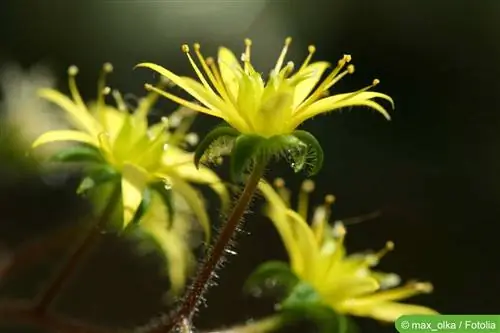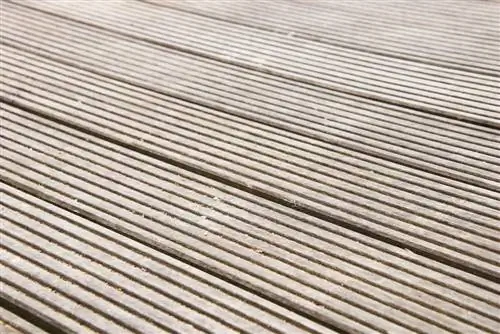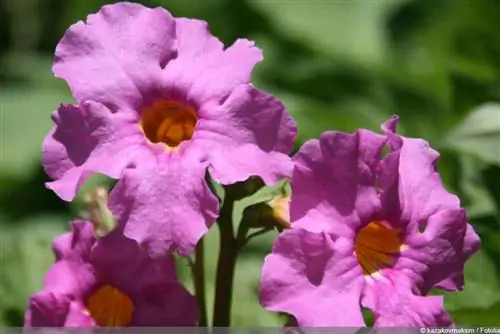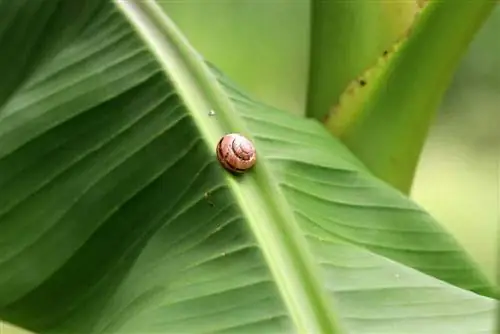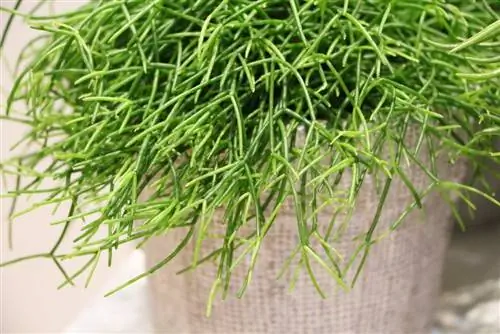- Author admin [email protected].
- Public 2023-12-17 03:39.
- Last modified 2025-01-24 12:45.
The Aichryson belongs to a small genus of succulents and is closely related to the Aeonium. Your plants look quite picturesque with their rounded leaves covered with fine and soft hairs. Whole clusters of pale yellow flowers appear at the ends of their branches in late spring or early summer and attract attention. In addition to their unusual visual impact, these small plants are also incredibly undemanding. The Aichryson laxum, for example, grows almost like a small tree. But all Aichrysons offer a beautiful picture in every location.
General
Most of the known Aichryson species are valued for their beautiful rosettes. Their flowering is also wonderful almost all year round. Afterwards, however, the rosette dies, but this does not affect its popularity. The vast majority of these known species come from the Canary Islands, the Azores and Madeira. There are two exceptions, which occur in Morocco and Portugal.
The succulent shoots and leaves of this genus can be hairy or smooth. Their flowers are yellow. Since they are closely related to Aeonium, they prefer the edges of pine and laurel forests in their homeland on the Canary Islands. All species prefer partial shade and moist soil with their dense and green cushions, even in our latitudes.
It is not difficult to cultivate Aichryson if they are protected from temperatures below 4 °C during the cold season. The Aichryson is a genus of plants that belongs to the family of thick-leaved plants (Crassulaceae). Its botanical name comes from Greek. It is derived from 'Aei' (stands for forever) and 'chrysos' (stands for gold).
Known species
- Aichryson bollei / one- to two-year-old, herbaceous plant, sparsely or simply branched. Growth height: 25 to 25 cm. The shoots are covered with hair along their entire length
- Aichryson brevipetalum / annual, simple or sparsely branched, densely hairy and herbaceous. Growth height: 5 to 8 cm. The shoots are completely hairy.
- Aichryson divaricatum / one- or two-year-old, sparsely branched, bare plant with herbaceous growth. Growth height: 10 to 30 cm. The shoots are bare.
- Aichryson dumosum / annual or biennial, fairly sparsely branched herbaceous plant, glabrous to sparsely hairy. Growth height: 15 to 30 cm. The shoots are bare.
- Aichryson laxum / annual or biennial herbaceous plant. Growth height: 15 to 30 centimeters, rarely up to 50 cm. The entire plant is covered with soft and protruding hairs, often red and quite fragile.
- Aichryson pachycaulon / two- or three-year-old herbaceous plant that tends to go bald. Growth height: from 20 to 35 cm. The shoots are bare.
- Aichryson palmense / two or three year old, glandular and herbaceous plant. Growth height: up to 20 centimeters. The shoots are clearly covered with hair.
- Aichryson parlatorei / annual, simple or sparsely branched. Densely hairy, herbaceous growth. Growth height: up to 12 cm. The lower part of the plant is usually covered with hair.
- Aichryson porphyrogennetos / two- or three-year-old, densely hairy, often colored purple. Herbaceous growth. Growth height: 15 to 45 cm. The shoots in the lower part covered with hairs.
- Aichryson punctatum / annual or biennial herbaceous plant. Growth height: 8 to 20 centimeters. Rarely up to 30 centimeters. The shoots are bare below and downy above.
- Aichryson villosum / annual, simple or sparsely branched plant. Densely hairy and herbaceous. Growth height: 8 to 18 cm. The shoots are densely hairy, but sometimes bare in the lower part.
- The Macrobia section includes:
- Aichryson bethencourtianum / perennial, densely branched small shrub. Growth height: up to 15 centimeters. The shoots are hairy, often bare below.
- Aichryson tortuosum / perennial, densely branched small shrub. Growth height: up to 15 centimeters. The shoots are hairy, often bare below.
Inflorescence and flowers
There are 6 to 12 inflorescences at the tips of the shoots. The style of the flowers is very thin and only 2 to 20 millimeters long. The cylindrical anthers are yellowish, thread-like and free-standing.
Seeds
The seeds of Aichryon are brownish and warty to ribbed.
Location
All Aichrysons need a bright location. They can also tolerate direct sun, but they should be protected from the blazing midday sun. If there is too little light, the plants shoot up, become sparse and do not produce flowers. Their leaves become very misshapen and die irrevocably. The plants need protection from strong winds because they are quite fragile.
Pouring
Even watering is required during the growing season. During the rest period, only water enough so that the pot ball does not dry out completely.
Temperature
Aichryson loves higher temperature ranges. At temperatures below 13 °C and with little light, the plant enters a short period of rest.
Propagate the plant
Propagation takes place via head cuttings. They are cut in spring and placed in a mixture of moist cake and sharp sand. They should be kept bright, but not in full sun, and should only be watered lightly. After rooting, they are planted in 7 to 8 cm pots and treated like a full-grown plant from then on.
Substrate / Soil
Aichryson does not place any special demands on the soil. It does very well in the garden with well-drained soil. However, very moist areas should be drained. Potting soil or standard soil can be used for pot planting.
Fertilize
All Aichryson species have only low nutrient requirements. It is therefore absolutely sufficient to supply the plants with a commercially available liquid fertilizer every 14 days during the main growing season.
Frequently asked questions
In our case the Aichryson sheds its lower leaves. What is the cause?
If a lot of leaves fall off, it may be that the plant is too warm, too dry or in the blazing sun. With a different location, some moisture and less sun, the damage will soon be repaired.
Help, my Aichrysons are getting too big for me. Can I cut them back?
That's not a problem. If the Aichryson plants become too large, they can easily tolerate pruning.
Can I actually prevent an insecticide infestation or possible fungal diseases on my Aichryson?
It is even advisable to take preventative action against such an infestation. If temperatures rise at the beginning of spring and nothing is blooming in the garden, an infestation can be prevented with a broad-spectrum insecticide. A broad-spectrum fungicide prevents the development of fungal diseases that could easily occur due to an increase in humidity.
What you should know about Aichryson in brief
- The Aichryson requires a bright location and can also tolerate direct sun. It should be protected from the blazing midday sun.
- If the plant has too little light, it becomes stunted, shoots up and does not produce flowers. The leaves become misshapen, elongated and die.
- The plants are grateful for a somewhat sheltered location as they are often quite fragile and strong winds can damage the plants.
- Potting soil and standard soil can be used as planting substrate.
- The pots for the plants can be small because the Aichryson only has small roots. That's why you don't have to repot so often.
- Watering regularly during the growing season, but only when the soil is completely dry.
- During the dormant phase, you only water so often that the root ball does not dry out completely.
- If you keep the planting substrate too moist, the roots will rot and the plant will die. It's better to water too little than too much!
- Fertilization is only carried out during the growing season and then every 14 days with a commercially available liquid fertilizer.
Editor’s Tip
Aichryson is propagated by head cuttings. These are cut in spring and planted in a mixture of peat and sand. It needs to be kept slightly but evenly moist. The cuttings need a lot of light, but should not be in the sun.
If the plant loses many of its lower leaves, it may mean that it is too warm or too dry or cannot tolerate the blazing sun. If the plants get too big, they can easily be cut back.

